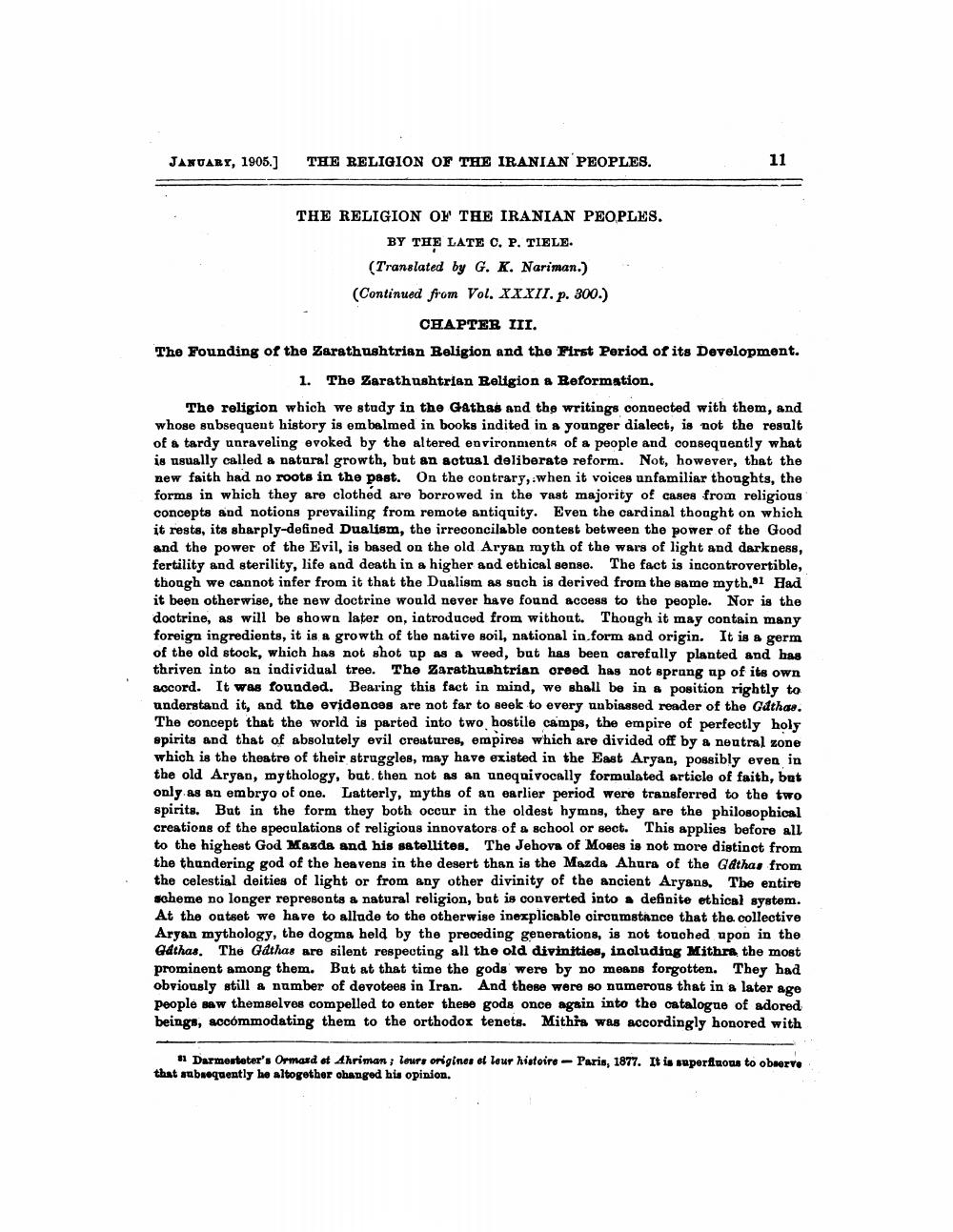________________
JANUARY, 1905.]
THE RELIGION OF THE IRANIAN PEOPLES.
II.
THE RELIGION OF THE IRANIAN PEOPLES.
BY THE LATE C, P, TIELE. (Translated by G. K. Nariman.) (Continued from Vol. XXXII. p. 300.)
CHAPTER III. The Founding of the Zarathushtrian Religion and the First Period of its Development.
1. The Zarathushtrian Religion a Reformation. The religion which we study in the Gathas and the writings connected with them, and whose subsequent history is embalmed in books indited in a younger dialect, is not the result of a tardy unraveling evoked by the altered environments of a people and consequently what is usually called a natural growth, but an actual deliberate reform. Not, however, that the new faith had no roots in the past. On the contrary, when it voices unfamiliar thoughts, the forms in which they are clothed are borrowed in the vast majority of cases from religious concepts and notions prevailing from remote antiquity. Even the cardinal thought on which it rests, its sharply-defined Dualism, the irreconcilable contest between the power of the Good and the power of the Evil, is based on the old Aryan myth of the wars of light and darkness, fertility and sterility, life and death in a higher and ethical sense. The fact is incontrovertible, though we cannot infer from it that the Dualism as such is derived from the same myth.01 Had it been otherwise, the new doctrine would never have found access to the people. Nor is the doctrine, as will be shown later on, introduced from without. Though it may contain many foreign ingredients, it is a growth of the native soil, national in form and origin. It is a germ of the old stock, which has not shot up as a weed, but has been carefully planted and has thriven into an individual tree. The Zarathushtrian orood has not sprang up of its own accord. It was founded. Bearing this fact in mind, we shall be in a position rightly to understand it, and the evidences are not far to seek to every unbiassed reader of the Gathas. The concept that the world is parted into two hostile camps, the empire of perfectly holy spirits and that of absolutely evil creatures, empires which are divided off by a neutral zone which is the theatre of their struggles, may have existed in the East Aryan, possibly even in the old Aryan, mythology, but then not as an unequivocally formulated article of faith, but only as an embryo of one. Latterly, myths of an earlier period were transferred to the two spirits. But in the form they both occur in the oldest hymns, they are the philosophical creations of the speculations of religions innovators of a school or sect. This applies before all to the highest God Masda and his satellites. The Jehova of Moges is not more distinct from the thundering god of the heavens in the desert than is the Mazda Ahura of the Gatha, from the celestial deities of light or from any other divinity of the ancient Aryans. The entire scheme no longer represonts a natural religion, but is converted into a definite ethical system. At the outset we have to allude to the otherwise inexplicable circumstance that the collective Aryan mythology, the dogma held by the preceding generations, is not touched upon in the Gdthas. The Gathas are silent respecting all the old divinities, including Mithra the most prominent among them. But at that time the gods were by no means forgotten. They had obviously still & number of devotees in Iran. And these were so numerous that in a later age people saw themselves compelled to enter these gods once again into the catalogue of adored beings, accommodating them to the orthodox tenets. Mithia was accordingly honored with
11 Darmerteter's Ormand at Ahriman ; leurs origines et leur histoire - Paris, 1877. It is superfluous to obnervo that subsequently he altogether changed his opinion.




